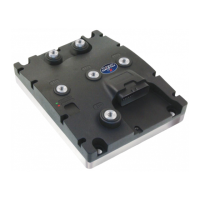SuperSigma2 AM PMS – V1.5.6 17-1-2020 Page 40 (97) ©2019 DMC GmbH Herten Germany
Dual Motor parameters
M1-61T Dual motor cut out ”DMcut”
M1-62T Dual motor angle 1 ”DMang1”
M1-63T Dual motor angle 2 ”DMang2”
M1-64T Dual motor angle 3 ”DMang3”
M1-65T Dual motor speed 1 ”DMspd1”
M1-66T Dual motor speed 2 ”DMspd2”
M1-67T Dual motor speed 3 ”DMspd3”
These parameters define the Dual Motor function. For them to be active, the parameter “M3-14TSingle or Dual Motor
”Si/DL/DR” must be set to 1, 2 or 3 (if set to 3, only “DMcut”, “DMang3” and “DMspd3” will be active).
The parameters are working in conjunction with steering pot. The steering angle is expressed as percentage and is defined
by the following parameters:
• “M1-56T Steer pot minimum ”StrMin”” sets -100% of steering angle
• “M1-57T Steer pot middle point ”StrMid”” sets 0% of steering angle
• “M1-58T Steer pot maximum ”StrMax”” sets 100% of steering angle
Parameter “M1-61T Dual motor cut out ”DMcut”” sets the steering angle at which the motor starts to reduce speed. If,
for example, a value of 10% is chosen, then the speed reduction will commence if the steering potentiometer is outside
of a central dead band of ± 10%.
In the central dead band, the inner motor speed is equal to the outer motor speed and corresponds to the driving speed
of the vehicle.
When the setting “M3-14TSingle or Dual Motor ”Si/DL/DR” is set to 1 or 2, the relationship between parameters from
M1-61T to M1-67T is explained below for both the inner and outer motors:
Inner motor:
• When the steering angle is between “M1-61T Dual motor cut out ”DMcut”” and “M1-62T Dual motor angle 1
”DMang1”” settings, the motor starts to reduce speed towards “M1-65T Dual motor speed 1 ”DMspd1””, while
it also reduces the torque towards zero.
• When the steering angle is between “M1-62T Dual motor angle 1 ”DMang1”” and “M1-63T Dual motor angle 2
”DMang2”” the torque of the inner motor is zero, meaning it is able to freewheel and the speed is left free.
• When the steering angle is beyond “M1-63T Dual motor angle 2 ”DMang2”” and towards “M1-64T Dual motor
angle 3 ”DMang3””, the inner motor reverses its spinning direction and torque is increased towards half the
demanded torque. The speed of the inner motor starts at “M1-66T Dual motor speed 2 ”DMspd2”” and is
increased towards half of the “M1-67T Dual motor speed 3 ”DMspd3”” setting.
• When steering beyond “M1-64T Dual motor angle 3 ”DMang3””, the torque of the inner motor is maintained at
half the demanded torque and the speed is set to half of the “M1-67T Dual motor speed 3 ”DMspd3”” setting.
Outer motor:
• When the steering angle is between “M1-61T Dual motor cut out ”DMcut”” and “M1-62T Dual motor angle 1
”DMang1”” settings, the speed of the outer motor is reduced towards “M1-67T Dual motor speed 3 ”DMspd3””.
• When the steering angle is between “M1-62T Dual motor angle 1 ”DMang1”” and “M1-63T Dual motor angle 2
”DMang2”” the speed of the outer motor is reduced from “M1-67T Dual motor speed 3 ”DMspd3”” towards half
of the “M1-67T Dual motor speed 3 ”DMspd3”” setting.
• Steering beyond the “M1-64T Dual motor angle 3 ”DMang3”” setting maintains the speed of the outer motor at
half the “M1-67T Dual motor speed 3 ”DMspd3”” setting.
• The torque of the outer motor is maintained at the demanded torque in the whole steering range.
The reason because both inner and outer motors are maintaining a speed which is half of “M1-67T Dual motor speed 3
”DMspd3”” above the “M1-67T Dual motor speed 3 ”DMspd3”” setting, is that they are spinning in opposite direction:
this therefore produces a total speed which is twice that of one motor.
The torque of the inner motor is halved to prevent a sudden increase in speed when steering rapidly beyond the “M1-
63T Dual motor angle 2 ”DMang2”“ setting.

